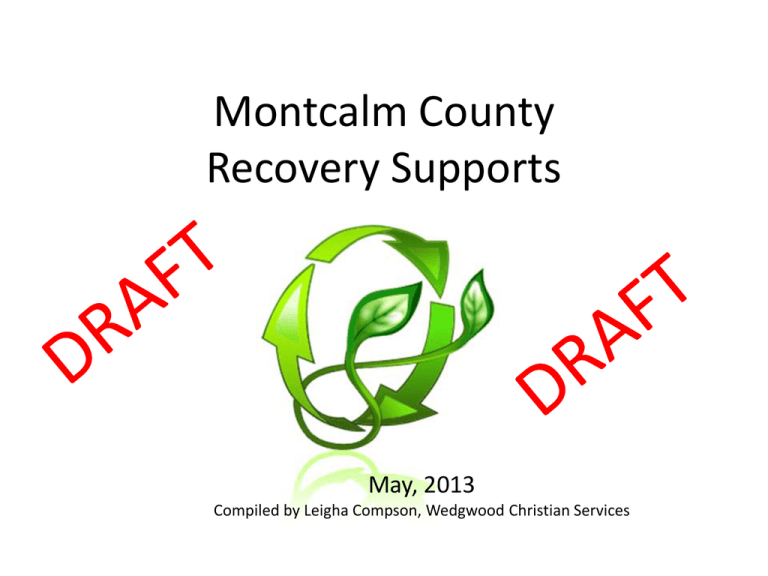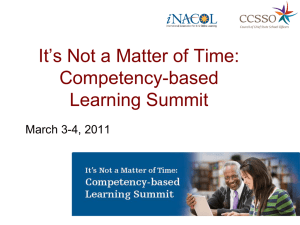Resource Mapping Presentation
advertisement

Montcalm County Recovery Supports May, 2013 Compiled by Leigha Compson, Wedgwood Christian Services Contents • • • • • Background of RISC Recovery Resource Supports Montcalm County Resources Contact Information References Background of RISC RISC Montcalm County Recovery and Integrated Services of Care (RISC) is committed to the following: • Vision: Montcalm County values all members of the community and provides individual and family recovery supports imbedded in employment, housing, public and private services and education. • Mission: To establish as many pathways as necessary to achieve substance use disorder recovery. RISC • RISC’s four core areas of focus are outlined in the graphic below as taken from the October, 2012 Strategic Plan • The slides that follow represent work in the area of Community Resource Mapping Recovery Resource Supports Recovery Resource Supports • The objective of categorizing support resources is to help individuals in recovery identify key supports needed to maintain sobriety. • By organizing recovery resources into four main categories, matching individuals with resources will be more efficient. • Mapping recovery resources across the county helps individuals identify resources that are more accessible. • Analyzing the mapped resources creates the opportunity to advocate for new resources in underserved areas. Recovery • Recovery from Mental Disorders and/or Substance Use Disorders: A process of change through which individuals improve their health and wellness, live a self-directed life, and strive to reach their full potential. (del Vecchio, 2012) Recovery Supports Substance use literature identifies four primary categories of support that are instrumental in recovery: • Emotional • Informational • Instrumental • Affiliation (Salzer, 2002a, 2002b as cited in Kaplan, 2008) Emotional Supports • Emotional Supports are defined as “demonstrations of empathy, caring, and concern in such activities as peer mentoring and recovery coaching as well as recovery support groups” (Kaplan, 2008). • Emotional Supports include – – – – Counseling Mentoring Spirituality Support Groups Instrumental Supports • • Instrumental Supports are defined as “concrete assistance in task accomplishment, especially with stressful or unpleasant tasks (e.g., filling out applications, obtaining public benefits) or providing supports such as child care, transportation to support group meetings, and clothing closets” (Kaplan, 2008). Instrumental Supports include – – – – – – – – – – Child Care Clothing Educational Systems Employment Food Healthcare Housing Legal System Transportation Tutors Informational Supports • Informational Supports are defined as “provision[s] of health and wellness information, educational assistance, and help acquiring new skills, ranging from life skills to employment readiness and citizenship restoration (e.g., voting rights, driver’s license)” (Kaplan, 2008). • Informational Supports include – Alternative Methods – Career Counseling – Family Education – Health and Wellness – Household Management – Job Training – Language Services – Leisure Education – Literacy Affiliation Supports • Affiliation Supports are defined as opportunities “to establish positive social connections with others in recovery so as to learn social and recreational skills in an alcohol-and drug-free environment.” (Kaplan, 2008). • Affiliation Supports include – – – – Counseling Mentoring Spirituality Support Groups Montcalm County Resources Montcalm County Resources Total Recovery Supports Resources: 728! Montcalm County Resources 115 179 Emotional Instrumental Affiliation Informational 128 306 Who can use this data? • Any person or family in the county may use this information • Organizations such as churches, counseling agencies, schools, and the court system may find benefit in having the list available • Specifically, recovery coaches may use this information to help individuals to develop recovery plans as part of counseling How will this data be accessed? • The resource map can be published on the RISC website • Resource booklets can be printed (in moderation) to distribute to key access points in the county • The RISC Steering committee can view and maintain the data through Google Docs Montcalm County Resource Map • Electronic maps of resources in Montcalm County have been created for each support category (i.e., emotional, instrumental, informational, and affiliation). • More specific resource maps have also been created for each subcategory under the four key categories (e.g., one map was developed specifically for food resources ). Montcalm County Mapped Resources Affiliation Supports Emotional Supports Informational Supports Instrumental Supports Community Involvement Counseling Alternative Methods Child Care Leisure Activities Mentoring Career Counseling Clothing Recovery Events Spirituality Family Education Educational Systems Volunteer Opportunities Support Groups Health and Wellness Employment Household Management Food Job Training Healthcare Language Services Housing Leisure Education Legal System Literacy Transportation Click on a resource category or subcategory above to view resource map Tutors Using the Map • When you get to the map page, you should see multiple colors of pins, with each color representing a different subcategory • To view the details of each resource, simply click on the pin on the map Using the Map • Each color pin represents a different subcategory (e.g., food is red) • To view resources for only one subcategory, click on the pin at the bottom of the map for the desired subcategory Using the Map If the map displays only one color of pin, simply click on that color in the key at the bottom of the map to redisplay all colors All colors are displayed after clicking the red pin Using the Map To navigate the map, • Click on the bar on the left to zoom in or out • Click and drag in the center of the map to view other portions Using the Map • To get directions to a specific resource, click on the pin and then on the name of the resource • A new window will load that shows the street view of the resource and gives you the option to enter a starting address Using the Map You may scroll down below the map for a list view of the resources Using the Map You may search the page for a specific resource by using the Ctrl-F function on the map page. Resources • A resource booklet that contains the resources that are displayed in the electronic map is available here (add link). • The resource booklet is organized into four main chapters, one chapter for each category • The booklet also contains an appendix of felony friendly jobs • A healthy leisure section is being developed Contact Information Contact Information • The mapped information is as of April, 2013 • For the most up to date resource information, you may wish to call the resource before visiting the site • For more information, assistance, or to request a resource addition or change , contact Montcalm RISC at montcalmrisc@gmail.com OR (616) 232-6891. References References Center for Substance Abuse Treatment (2009). What are Peer Recovery Support Services? HHS Publication No. (SMA) 09-4454. Rockville, MD: Substance Abuse and Mental Health Services Administration, U.S. Department of Health and Human Services. del Vecchio, P. (2012). SAMHSA’s Working Definition of Recovery Updated. Retrieved from http://blog.samhsa.gov/2012/03/23/defintion-of-recovery-updated. Kaplan, L. (2008). The Role of Recovery Support Services in Recovery-Oriented Systems of Care. DHHS Publication No. (SMA) 08-4315. Rockville, MD: Center for Substance Abuse Treatment, Substance Abuse and Mental Health Services Administration Salzer, M. (2002a). Best practice guidelines for consumer-delivered services. Unpublished paper developed for Behavioral Health Recovery Management Project. An initiative of Fayette Companies, Peoria, IL; Chestnut Health Systems, Bloomington, IL; and the University of Chicago Center for Psychiatric Rehabilitation. From www.bhrm.org/guidelines/salzer.pdf (accessed May 15, 2007). Salzer, M. (2002b). Consumer-delivered services as a best practice in mental health care delivery and the development of practice guidelines. Psychiatric Rehabilitation Skills, 6 (3), 355-383 Substance Abuse and Mental Health Services Administration. (2009). Designing a Recovery-Oriented Care Model for Adolescents and Transition Age Youth with Substance Use or Cooccurring Mental Health Disorders. Rockville, MD: U.S. Department of Health and Human Services. Virginia Substance Abuse Recovery Support. (n.d.). Retrieved from http://www.dbhds.virginia.gov/documents/VaRecoverySupportModelRFP.pdf Future additions • Generate maps of subcategories, pending feedback • Hard copies of resources in a booklet format • Google doc of word document • Pie charts - # of resources • Maintenance plan • Distribution plan






